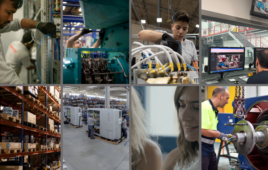
By Hitachi ABB Power Grids
Wind power is one of humanity’s biggest hopes for an affordable, carbon-neutral energy future, being one of the preferred technologies – alongside solar – for energy companies to invest in. Although wind power is abundant on land, we must go to the seas and oceans to satisfy our current and future sustainable energy needs. But this is not a task for everyone – it takes courage, expertise, and a pioneering spirit to do it. And not many companies are capable of operating offshore assets, which need to stand up to constant exposure from nature’s harshest elements.
Norway’s Equinor is one of the first oil and gas majors to enter the offshore wind market. The company has decades of experience with building and operating large offshore energy infrastructures, scaling up new technologies, setting standards, and excelling at health and safety.
Since the early days, Hitachi ABB Power Grids has supported wind turbine manufacturers and operators of wind farms with innovative solutions. Together with customers and partners, the wind pioneer is contributing to the transformation of the industry – making wind energy a resilient and reliable power generation technology.
Both companies are planning to take the offshore wind sector to the next level.

(L) Rajnish Sharma is VP of Renewable Projects at Equinor, (C) Adrian Timbus is Chairman of the Executive Committee of European Technology and Innovation Platform Wind, and Head of Portfolio at Hitachi ABB Power Grids, (R) Alfredo Parres is Head of Renewables at Hitachi ABB Power Grids
What will the ‘next level’ look like?
Offshore wind has shown its competitiveness compared with other sustainable energy sources, such as solar and onshore wind, which are easier and cheaper to develop. The segment however needs to use all the available intelligence to further innovate and prove its competitiveness.
“If we look at the development of the Levelized Cost of Energy (LCOE) of offshore wind power, it has declined a lot in the past five to seven years. There are many factors that have contributed to that, but the key ones are technological development, increased competition, learning rate, scale and volume, and cost of finance. We believe that with further technological innovation we will see even lower LCOE towards 2030 and beyond to 2050,” says Rajnish Sharma, Vice Present of Renewable Projects at Equinor.
Technological development of the wind turbines has been one of the key factors contributing to the reduction of LCOE for offshore wind. Their size grew dramatically in the last years, reaching sizes of 14 MW today. “My personal view is that we will see 20 MW+ turbines by 2030,” continues Rajnish.
Scaling up power levels makes turbines more efficient and harvests more wind energy.
“But to optimize costs across the overall system, one needs to also consider the voltage level at which the equipment operates. For 20 MW+ turbines, our studies show that we can get a higher efficiency and a lower cost of the overall system if we use 132 kV voltage levels,” explains Alfredo Parres, Head of Renewables at Hitachi ABB Power Grids.
And offshore wind continues to go larger, farther, and deeper. Just a few years back, we were developing 600 to 700 MW wind farms. Now 1.2 GW has become the typical size. The addition of 1.5 to 2 GW wind farms that we see ahead creates constraint-related questions for grid connection capacity. For these wind farms, we need efficient and resilient transmission solutions such as HVDC operating at extra high voltage levels.
“But can we go to 525 kV DC? That’s something we would expect to work on together with technology leaders like Hitachi ABB Power Grids,” says Rajnish.

Equinor’s Hywind Scotland is the world’s first floating offshore wind farm
“With Hywind Scotland, we have shown that the technology works. In the first two years of its operations, it had the highest capacity factor in the UK with an average of 54 percent, while other offshore wind farms in the UK are at 40 percent. In that last 12 months up to March 2021, we even saw an average of 57 percent. Because of its incipient state and undeveloped supply chain, the cost of floating wind is still higher compared with fixed wind. We have proven however that we can considerably bring the costs down through industrialization and scale. Between our Hywind Demo and Hywind Scotland projects, we managed to reduce capex by 70 percent. Between Hywind Scotland and Hywind Tampen, our ambition is to reduce capex by another 40 percent,” he continues.
Read the full articleSponsored content by Hitachi ABB Power Grids
Filed Under: Sponsored Content




